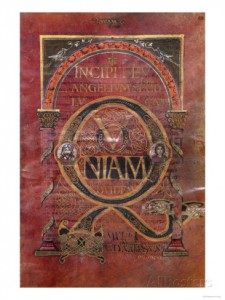For the sake of completion to my recent posts on empty tombs and crucifixions being popular stuff of ancient fiction I should add the most well-known one here, the section from the first century Satyricon by Petronius. (Those recent posts are Popular novels and the gospel narratives and Another Empty Tomb Tale.)
The date
Michael Turton in his Historical Commentary on the Gospel of Mark includes the following comment on Mark 16:8
v8: Carrier (2004c) observes:
“But we have one definite proof that the resurrection motif in fiction predates the 1st century: the Latin satire of that very genre, The Satyricon by Petronius. This is positively dated to around 60 A.D. (Petronius was killed under the reign of Nero, and makes fun of social circumstances created by the early Caesars) and is a full-fledged travel-narrative just like Acts, with a clear religious motif. However, Petronius is making fun of that motif, and also writing in Latin, yet we know the genre began in the Greek language. Thus, in order for Petronius to move the genre into Latin and make fun of it, it must have pre-existed the time of his writing and been popular enough to draw his attention. Indeed, the satire itself may actually have existed in a Greek form before Petronius took it up: P. Parsons, “A Greek Satyricon?” Bulletin of the Institute of Classical Studies 18 (1971) pp. 53ff. It should be noted that Petronius pokes fun at the resurrection theme. Similarly, Plutarch relates a spoof of the motif in popular theatre, where a performing dog acts out its death and resurrection on stage to the delight of the emperor Vespasian (“On the Cleverness of Animals,” Moralia 973e-974a). In order to have something to spoof, the motif must predate the year 80.” in section 140.frg2, where the hero compares his restoration from impotence to the “resurrected Protesilaus,” and attributes it to Mercury’s known role in “bringing back the dead.”
The Widow of Ephesus tale
With permission from, and thanks to, the owner of The Above-average Typist site (Kenny), I am copying from his site the portion of “Chapter Thirteen” from: The Satyricon by Petronius. Translated by Alfred R. Allinson. (1930) pp. 193-218. This site contains the complete text of the Satyricon.
In this instance we have not an empty tomb, but a “resurrection” from a tomb of a body that ended back on the cross!
But Eumolpus, champion of the distressed and author of the existing harmony, fearing that our cheerfulness should flag for lack of amusing anecdotes, commenced a series of gibes at women’s frailty,– how lightly they fell in love, how quickly they forgot even their own sons for a lover’s sake, asserting there was never yet a woman so chaste she might not be wrought to the wildest excesses by a lawless passion. Without alluding to the old plays and world-renowned examples of women’s folly, he need only instance a case that had occurred, he said, within his own memory, which if we pleased he would now relate. This offer concentrated the attention of all on the speaker, who began as follows:
cxi “There was once upon a time at Ephesus a lady of so high repute for chastity that women would actually come to that city from neighboring lands to see and admire. This fair lady, having lost her husband, was not content with the ordinary signs of mourning, such as walking with hair disheveled behind the funeral car and beating her naked bosom in presence of the assembled crowd; she was fain further to accompany her lost one to his final resting-place, watch over his corpse in the vault where it was laid according to the Greek mode of burial, and weep day and night beside it. So deep was her affliction, neither family nor friends could dissuade her from these austerities and the purpose she had formed of perishing of hunger. Even the Magistrates had to retire worsted after a last but fruitless effort. All mourned as virtually dead already a woman of such singular determination, who had already passed five days without food.
“A trusty handmaid sat by her mistress’s side, mingling her tears with those of the unhappy woman, and trimming the lamp which stood in the tomb as often as it burned low. Nothing else was talked of throughout the city but her sublime devotion, and men of every station quoted her as a shining example of virtue and conjugal affection.
“Meantime, as it fell out, the Governor of the Province ordered certain robbers to be crucified in close proximity to the vault where the matron sat bewailing the recent loss of her mate. Next night the soldier who was set to guard the crosses to prevent anyone coming and removing the robbers’ bodies to give them burial, saw a light shining among the tombs and heard the widow’s groans. Yielding to curiosity, a failing common to all mankind, he was eager to discover who it was, and what was afoot.Accordingly he descended into the tomb, where beholding a lovely woman, he was at first confounded, thinking he saw a ghost or some supernatural vision. But presently the spectacle of the husband’s dead body lying there, and the woman’s tear-stained and nail-torn face, everything went to show him the reality, how it was a disconsolate widow unable to resign herself to the death of her helpmate. He proceeded therefore to carry his humble meal into the tomb, and to urge the fair mourner to cease her indulgence in grief so excessive, and to leave off torturing her bosom with unavailing sobs. Death, he declared, was the common end and last home of all men, enlarging on this and the other commonplaces generally employed to console a wounded spirit. But the lady, only shocked by this offer of sympathy from a stranger’s lips, began to tear her breast with redoubled vehemence, and dragging out handfuls of her hair, she laid them on her husband’s corpse.
“The soldier, however, refusing to be rebuffed, renewed his adjuration to the unhappy lady to eat. Eventually the maid, seduced doubtless by the scent of the wine, found herself unable to resist any longer, and extended her hand for the refreshment offered; then with energies restored by food and drink, she set herself to the task of breaking down her mistress’s resolution. ‘What good will it do you,’ she urged, ‘to die of famine, to bury yourself alive in the tomb, to yield your life to destiny before the Fates demand it?
“‘Think you to pleasure thus the dead and gone?
“‘Nay! rather return to life, and shaking off this womanly weakness, enjoy the good things of this world as long as you may. The very corpse that lies here before your eyes should be a warning to make the most of existence.’
“No one is really loath to consent, when pressed to eat or live. The widow therefore, worn as she was with several days’ fasting, suffered her resolution to be broken, and took her fill of nourishment with no less avidity than her maid had done, who had been the first to give way.
cxii “Now you all know what temptations assail poor human nature after a hearty meal. The soldier resorted to the same cajolements which had already been successful in inducing the lady to eat, in order to overcome her virtue. The modest widow found the young soldier neither ill-looking nor wanting in address, while the maid was strong indeed in his favor and kept repeating:
“Why thus unmindful of your past delight,
Against a pleasing passion will you fight?”“But why make a long story? The lady showed herself equally complaisant in this respect also, and the victorious soldier gained both his ends. So they lay together not only that first night of their nuptials, but a second likewise, and a third, the door of the vault being of course kept shut, so that anyone, friend or stranger, that might come to the tomb, should suppose this most chaste of wives had expired by now on her husband’s corpse. Meantime the soldier, entranced with the woman’s beauty and the mystery of the thing, purchased day by day the best his means allowed him, and as soon as ever night was come, conveyed the provisions to the tomb.
“Thus it came about that the relatives of one of the malefactors, observing this relaxation of vigilance, removed his body from the cross during the night and gave it proper burial. But what of the unfortunate soldier, whose self-indulgence had thus been taken advantage of, when next morning he saw one of the crosses under his charge without its body! Dreading instant punishment, he acquaints his mistress with what had occurred, assuring her he would not await the judge’s sentence, but with his own sword exact the penalty of his negligence. He must die therefore; would she give him sepulture, and join the friend to the husband in that fatal spot?
“But the lady was no less tender-hearted than virtuous. ‘The Gods forbid,’ she cried, ‘I should at one and the same time look on the corpses of two men, both most dear to me. I had rather hang a dead man on the cross than kill a living.’ So said, so done; she orders her husband’s body to be taken from its coffin and fixed upon the vacant cross. The soldier availed himself of the ready-witted lady’s expedient, and next day all men marveled how in the world a dead man had found his own way to the cross.”


